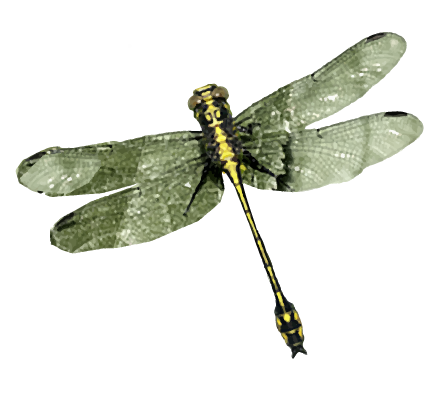Riverine Clubtail

Species information
The following is a report on progress made towards the protection and recovery of Riverine Clubtail (Stylurus amnicola) in Ontario from 2007 to 2020, based on Ontario’s species-specific recovery policy. This report meets the legislative requirement for a review of progress under the Endangered Species Act, 2007 (ESA or “the Act”). Riverine Clubtail is listed as endangered on the Species at Risk in Ontario (SARO) List under the ESA.
Riverine Clubtail was listed as an endangered species under the ESA on June 27, 2014.
Riverine Clubtail has been protected from being killed, harmed, harassed, captured or taken since 2014.
In addition, the habitat of Riverine Clubtail has been protected from being damaged or destroyed since 2014.
The species-specific recovery policy for Riverine Clubtail, known as the Government Response Statement (GRS), was published in 2016 and includes the government’s recovery goal for the species and the actions and priorities it intends to lead or support to help achieve that goal. The GRS considers science advice provided in the recovery strategy, when developing recovery actions for the species. As legislated in the Act, the purpose of this review is to report on progress made towards implementing the protection and recovery actions in the GRS. The review can also help identify opportunities to adjust and adapt the implementation of protection and recovery actions to achieve the recovery goal for the species.
Further information about Riverine Clubtail, including the threats that it faces, and actions being taken to help protect and recover this species is available on the Government of Ontario webpage for Riverine Clubtail. A summary on the progress towards the protection and recovery of Riverine Clubtail and an annual update on the broader species at risk program (i.e. the Introduction to the 2021 Review of Progress report) is available on the Review of Progress towards the Protection and Recovery of Ontario’s Species at Risk webpage.
Snapshot: Progress towards the protection and recovery of Riverine Clubtail
Progress towards meeting the recovery goal
- The recovery goal in the Government Response Statement (GRS) for Riverine Clubtail in Ontario is to “maintain viable, self-sustaining populations across the existing range of the species in Ontario”.
- Progress has been made towards implementing the majority of the government-led actions. Progress has been made towards implementing all of the government-supported recovery objectives and several of the associated actions. Examples of progress include:
- conducting presence/absence surveys for Riverine Clubtail in areas of suitable habitat where observations of the species have not been made
- identifying the structure of the vegetation community present at existing locations
- maintaining and enhancing habitat for Riverine Clubtail at existing locations in collaboration with local partners, municipalities and conservation authorities
- In alignment with the GRS, greater efforts are needed to integrate searches for Riverine Clubtail into ongoing benthic inventory programs in streams across Ontario and undertake research to determine the species' life processes and habitat needs at each of its developmental stages.
Occurrences and distribution
- Five populations of Riverine Clubtail have been documented in Ontario. Currently, all five of these populations are extant. Three populations of Riverine Clubtail have been newly-identified since 2008 (including one in 2020), while two populations were reconfirmed.
Government-supported stewardship projects
- Through the Species at Risk Stewardship Program, the Government of Ontario has enabled its stewardship partners to conduct three projects (by providing $171,874 in funding) that have supported the protection and recovery of Riverine Clubtail. One project focused exclusively on Riverine Clubtail, while the other 2 projects focused on multiple species at risk, including Riverine Clubtail.
- The government’s support helped its stewardship partners to involve 1,089 individuals who volunteered 3,493 hours of their time towards protection and recovery activities for species at risk, including Riverine Clubtail. The estimated value of these voluntary contributions, as well as additional funding and in-kind support, is $245,055.
- Stewardship partners reported that through their actions 63 hectares of habitat were enhanced for Riverine Clubtail and other species at risk that inhabit the same ecosystem.
- Stewardship partners reported providing outreach on multiple species at risk, including Riverine Clubtail, to 7,000 individuals.
Supporting human activities while ensuring appropriate support for species recovery
- Two activities have been registered for the species. The activities were registered under ‘Threats to health and safety, not imminent’ (section 23.18) under Ontario Regulation 242/08 of the ESA.
Reporting on the progress towards the protection and recovery of Riverine Clubtail
Recovery goal
The government’s goal for the recovery of Riverine Clubtail is to maintain viable, self-sustaining populations across the existing range of the species in Ontario.
The implementation of government-led and government-supported actions demonstrates progress towards reaching the desired objectives and the recovery goal set out in the GRS.
Progress towards implementing government-led actions
Progress has been made towards implementing the majority of government-led actions identified in the GRS. Common actions for the government to lead as it works towards achieving a species’ recovery goal include:
- Educate other agencies and authorities involved in planning and environmental assessment processes on the protection requirements under the ESA.
- Encourage the submission of Riverine Clubtail data to the Government of Ontario’s central repository at the Natural Heritage Information Centre (NHIC).
- Undertake communications and outreach to increase public awareness of species at risk in Ontario.
- Protect the Riverine Clubtail and its habitat through the ESA.
- Support conservation, agency, municipal and industry partners, and Indigenous communities and organizations to undertake activities to protect and recover the Riverine Clubtail. Support will be provided where appropriate through funding, agreements, permits (including conditions) and/or advisory services.
- Encourage collaboration, and establish and communicate annual priority actions for government support in order to reduce duplication of efforts.
Additionally, the government has directly undertaken the following species-specific actions:
- Continue to implement the Ontario Invasive Species Strategic Plan to address the invasive species (e.g., Round Goby, Rusty Crayfish, Zebra Mussels) that threaten Riverine Clubtail.
- Continue to manage the habitat of Riverine Clubtail in provincially protected areas to maintain the ecological integrity of its habitat and to minimize the threat of recreational pressures and impacts.
Key progress made towards implementing these actions is described in the following sections.
Ontario’s Invasive Species Act
The GRS for Riverine Clubtail indicates that invasive species (e.g. Round Goby) pose a threat to the survival and recovery of the species in Ontario. The Ontario Invasive Species Strategic Plan, 2012 and the Invasive Species Act, 2015 provide the policy and legislative framework to prevent new invaders from arriving and surviving in Ontario; to slow and where possible reverse the spread of existing invasive species, and to reduce the harmful impacts of existing invasive species, including impacts on species at risk. This framework may support the implementation of actions to reduce the threats from invasive species.
Occurrences and distribution
Five populations of Riverine Clubtail have been documented in Ontario. All five are considered to be extant (i.e., observed within the past 20 years). The extant populations are located in Big Otter Creek, Big Creek, Big East River, Chutes Provincial Park, and Spanish River.
Since 2014, the government’s central repository at the Natural Heritage Information Centre has received 51 records of the species. These records are based on observations between 2007 and 2020 and come from a variety of sources. Records submitted have helped to refine where the species is known and has been known to occur and have provided additional information on the species’ habitat and threats.
Increased monitoring since 2008 in areas where Riverine Clubtail is found has re-confirmed two populations that were observed before 2008 within Big Otter Creek (first observation in 1999) and Big Creek. Three new occurrences in Ontario were discovered in 2014 (Chutes Provincial Park), 2015 (Spanish River) and 2020 (Big East River). Many of the observations submitted are a result of targeted sampling for the species. The viability of two local populations are ranked as good or fair. The viability of the remaining three extant populations has not yet been assessed. Four of the local populations have had observations of live adults, two of which had evidence of reproductive females. The Spanish River occurrence has only been confirmed by one collected exuviae (larval casing). Finally, a 2018 Species at Risk Stewardship Program project has gathered data that may expand the species distribution, that has not yet been integrated to the provincial occurrence data (See Government-supported stewardship projects). The newly identified local populations are likely the result of increased search effort and education about Riverine Clubtail and may not represent actual population increases, but rather increased knowledge about the distribution of the species.
It is possible that there are observations of Riverine Clubtail that have not been submitted to the government. Encouraging the submission of observations of this species is included in the GRS as a government-led action. Submission of species observations increases our knowledge of where they occur and can play an important role in assessing the viability of species populations.
Everyone is encouraged, or may be required by an authorization or approval, to submit observations of Riverine Clubtail, and any other species at risk observed, to the NHIC for incorporation into the provincial record of observations.
-
51observations of this species were submitted to the NHIC since 2014
Government-supported stewardship projects
An important government-led action in the GRS for Riverine Clubtail is to support partners to undertake activities to protect and recover the species. Through the Species at Risk Stewardship Program the government has supported three projects ($171,874) designed to contribute to the protection and recovery of Riverine Clubtail. One of these projects focused exclusively on the species, while the other two projects focused on multiple species at risk, including Riverine Clubtail. In addition to the government funding, partners focusing exclusively on Riverine Clubtail reported they were successful in securing additional funding from other sources, as did partners with projects designed to benefit multiple species at risk, including Riverine Clubtail ($245,055). These amounts include in-kind support in the form of time and expertise provided by volunteers.
Stewardship partners reported that provincial funding helped them to secure in-kind support by involving individuals who volunteered 30 hours of their time towards protection and recovery activities that focused exclusively on Riverine Clubtail. As well, 1,089 individuals volunteered 3,463 hours of their time towards protection and recovery activities for multiple species at risk, including Riverine Clubtail, which has an estimated value of $95,055. Partners also reported that through both their efforts and the efforts of their volunteers to implement GRS actions, they were successful in enhancing 63 hectares of habitat that will benefit multiple species at risk, including Riverine Clubtail. In addition, stewardship partners reported providing ecosystem-based outreach on multiple species, including Riverine Clubtail, to 7,000 individuals.
The remainder of this section highlights two projects supported through the Species at Risk Stewardship Program as well as the corresponding government-supported recovery actions for the species.
In 2018, researchers at Cambrian College conducted surveys for Riverine Clubtail exuviae (larval skin cast-offs) along vegetated rivers in the southern Boreal shield of Ontario. Of the 2,399 exuviae collected, only three were identified as Riverine Clubtail. However, two of these collections from Vermillion River in Larchwood, Ontario expanded the species’ known distribution by approximately 85 kilometres. In addition, this project identified 35 areas with potentially suitable habitat for the Riverine Clubtail
In 2016 and 2017, Sault Ste. Marie Field Naturalists led surveys for Riverine Clubtail exuviae along the Goulais River in the Algoma District of Ontario. With assistance from Sault College Ontario students, they collected 1,453 exuviae, representing 15 species over 153 person-days in the field. In addition, a total of 240 hours was spent in the identification and cataloguing of these specimens. However, no exuviae were identified as Riverine Clubtail, further emphasizing the rarity of this species.
These projects supported actions under the GRS objective to determine the distribution, abundance, and habitat needs of Riverine Clubtail.
Species at Risk Stewardship Program
-
 3
3projects included Riverine Clubtail
-
 1
1project for Riverine Clubtail exclusively
-
 $171,874
$171,874for multi-species projects that included Riverine Clubtail
-
 $245,055
$245,055in additional funding and in-kind support
-
 1,089
1,089volunteers
-
 3,493
3,493volunteer hours
-
 7,000
7,000people received outreach
-
 63
63hectares of habitat enhanced
Supporting human activities while ensuring appropriate support for species recovery
Supporting partners through authorizations and their associated conditions is an important government-led action. To date, no permits have been issued for Riverine Clubtail.
Two activities that may affect Riverine Clubtail or its habitat have been registered for the purposes of Ontario Regulation 242/08 under the ESA. These were registered under ‘Threats to health and safety, not imminent’ (section 23.18), which requires the registrant to comply with all conditions of the regulation, such as:
- ensuring that reasonable steps are taken to minimize adverse effects of the activity on the species identified in the notice of activity form
- preparing a mitigation plan using best available information on steps that may help minimize or avoid adverse effects on the species
- reporting observations of the species using the Ontario Species at Risk Observation Reporting Form and submitting it to the NHIC
-
2registrations
Progress towards implementing government-supported actions
Government-supported actions are organized under overarching recovery objectives. Progress has been made towards achieving all government-supported recovery objectives and implementing several of the associated actions identified in the GRS for Riverine Clubtail.
Objective: Determine the distribution, abundance, and habitat needs of Riverine Clubtail and increase knowledge of the species' life processes and its threats.
- Action No. 1 (High Priority) - Develop and implement a standardized survey and monitoring protocol to:
- conduct presence/absence surveys for Riverine Clubtail in areas of suitable habitat where observations of the species have not been made
- estimate the abundance of Riverine Clubtail at existing locations
- identify the structure of the vegetation community present at existing locations
- monitor the extent of road mortality at existing locations
- Action No. 2 (High Priority) - Determine the species' tolerance to threats such as changes to its aquatic habitat, environmental contamination, and invasive species.
- Action No. 3 - Integrate searches for Riverine Clubtail into ongoing benthic inventory programs in streams across Ontario.
- Action No. 4 - Undertake research to determine the species' life processes and habitat needs (e.g., home range size and foraging distances) at each of its developmental stages (i.e., egg, larval, and adult stages) to better implement protection and recovery actions for the species.
Under this objective, progress has been made towards Action No. 1, while initial progress has been made towards Action No. 2. The first action has been implemented through projects supported by the Species at Risk Stewardship Program. Two projects conducted presence/absence surveys for Riverine Clubtail and supported reconfirming its presence in Ontario. In addition, one project identified vegetation community structure and quantified other habitat parameters at suitable habitat locations, which contributes to Action No. 2.
Objective: Maintain and enhance the quality of existing Riverine Clubtail habitat.
- Action No. 5 - Maintain and enhance habitat for Riverine Clubtail at existing locations in collaboration with local partners, municipalities and conservation authorities by:
- restoring natural vegetation bordering along occupied reaches of streams
- removing both aquatic and terrestrial invasive species that pose a threat to Riverine Clubtail habitat using appropriate methods
- Action No. 6 - Conduct outreach activities to raise awareness amongst landowners, land managers and municipalities about Riverine Clubtail, its habitat, and strategies to prevent the spread of invasive species in existing locations.
Under this objective, initial progress has been made towards Action No. 5 and progress has been made towards Action No. 6. Both actions have been implemented through a project supported by the Species at Risk Stewardship Program. Stewardship partners reported that provincial funding helped them to provide ecosystem-based outreach on multiple species, including Riverine Clubtail, to 7,000 individuals, and they were successful in enhancing 63 hectares of habitat that can support Riverine Clubtail.
Summary of progress towards meeting the recovery goal
The recovery goal for Riverine Clubtail is to “maintain viable, self-sustaining populations across the existing range of the species in Ontario”. Effort made towards the government-led and government-supported actions has helped to make progress towards this goal. For example, the number of verified provincial local populations, as well as the known area of the species’ existing Ontario range, have both increased since the finalization of the GRS, based on survey efforts and reporting to the NHIC. Additionally, the structure of the vegetation communities present at known Riverine Clubtail locations has also been identified, expanding our knowledge of the species’ habitat needs.
Recommendations
As stated in the GRS, this review of progress can be used to help identify whether adjustments to the implementation of GRS actions are needed to achieve the protection and recovery of the species. Based on progress to date, the overall direction provided in the GRS for Riverine Clubtail, particularly the implementation of actions identified as high priority, should continue to guide protection and recovery of the species.
Although initial progress has been made towards the action to determine the species' tolerance to threats such as changes to its aquatic habitat, environmental contamination, and invasive species (Action 2), further work is required to fully implement this action.
Relative to actions that have received a stronger level of support, the following actions have received less attention and are identified for consideration in future work towards the protection and recovery of the species:
- Action No. 3 - Integrate searches for Riverine Clubtail into ongoing benthic inventory programs in streams across Ontario.
- Action No. 4 - Undertake research to determine the species' life processes and habitat needs (e.g., home range size and foraging distances) at each of its developmental stages (i.e., egg, larval, and adult stages) to better implement protection and recovery actions for the species.
Protecting and recovering Riverine Clubtail will continue to be a shared responsibility that will require the involvement of many individuals, organizations and communities. Financial support for the implementation of actions may be available through the Species at Risk Stewardship Program. The government can also advise if any authorizations under the ESA or other legislation may be required to undertake a project. By working together, progress can continue to be made towards protecting and recovering Riverine Clubtail in Ontario.